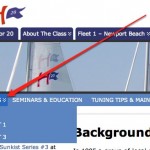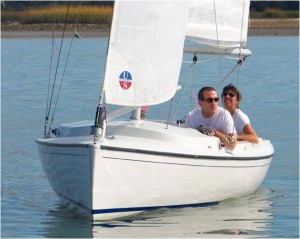If your reading this article, you have noticed the new Harbor 20 Class Association website. We hope you like it!
The new site has been completely redesigned from the ground up, with new navigation and new pages. The purpose of the site is to:
- Promote the Harbor20 Class
- Post Class & Fleet News and Events
- Post information about educational seminars
- Post Race Information (NOR’s, Sailing Instructions, Course Charts and Results)
- Post information about the Harbor20 including tips on maintenance and tuning
- Post classified ads on used Harbor20’s for sale
- Promote communication between Class & Fleet members
About the Class menu item
This section contains pages about the Class, including the History of the Harbor 20, the Class Organization (including the current ByLaws and Officiers), the current Champions and a link to a form to Join.
Fleet 1 – Newport Beach menu item
This section contains pages related to the largest Fleet in the Class: Fleet 1 (Newport Beach). Within the menu is information about the Organization (the Fleet Bylaws and Officers), the current and past Fleet 1 Champions, the current “A” Fleet qualifiers, the Racing and Events calendar, the Awards, a list and summary of all the regularly scheduled Regattas and the race results. Fleet 1 is a very active fleet and these pages are updated often and after every race.
The Results page displays up-to-date race stats of every race, including the season-long High Point and Rain or Shine series leaders.
Fleet 2 – San Diego, Fleet 3 – Hilton Head, Fleet 4 – Santa Barbara menu items
These sections of the website have been reserved for the each of these (and future) fleets. The new site is built on the WordPress Content Management System, which allows any authorized users to quickly and easily update pages and post content to the website. Officers and leaders of these fleets are encouraged to use this new website to post information about their fleet.
News
The News section of the website consists of post by Class members, typically consisting of articles, reports of races, articles about awards, or anything newsworthy, entertaining or related to the Harbor20 Class. All Class members are invited to contribute. If you would like to contribute, please contact the webmaster for your own user contribution account.
Seminars & Educations, Tuning Tips & Maintenance, Classified Ads
Each of these sections contain posts by Class Members about upcoming events or their own contributions.
Our goal with this new website is to have Class Members start to contribute their own thoughts, knowledge, stories and experiences for the benefit of all the other Class Members. We also hope to have all Harbor20 Fleets begin to use the Website to for their own Fleet. Please contact the Webmaster, Nik Froehlich, if you would like access to contribute.








